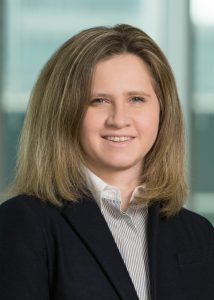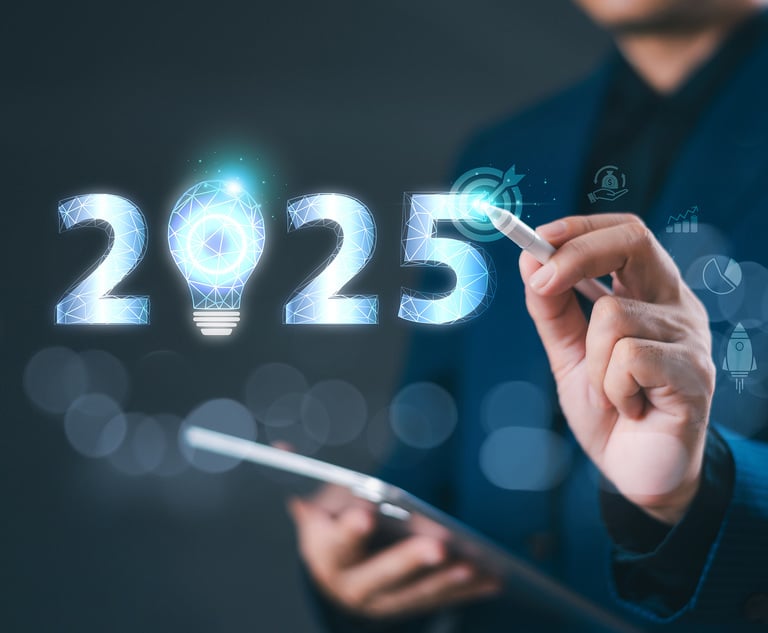Evolving Nature of Functional Claiming in Software-Related Inventions
The line between promoting and stifling innovation can become a bit fuzzy. In light of evolving statue application, patent practitioners should be careful, write Peter Sistare and Maya Yusim of Drinkler Biddle.
June 05, 2019 at 12:28 PM
6 minute read
 (Photo: Shutterstock.com)
(Photo: Shutterstock.com)
One purpose of the patent system is to promote, not stifle, innovation. This line between promoting and stifling innovation can become a bit fuzzy. For example, patentees seek to protect functionality of their inventions by use of functional claim limitations that describe claim features in terms of their results without providing any specificity as to what the features are or how the claimed results are accomplished. On the face of it, such functional claim limitations may cover all ways of accomplishing the claimed results, including ways that are unknown at the time of the invention, which may deter others from attempting to invent improved ways of achieving the results.
Congress recognized this potentially detrimental effect of functional claiming and in the Patent Act of 1952 introduced a statute that limited the scope of a functionally claimed limitation to cover “the corresponding structure, material, or acts described in the specification and equivalents thereof.” This statute, currently codified under 35 U.S.C. § 112(f), has remained essentially unchanged since its inception. But, as with many aspects of patent law, application of the statute has evolved and particularly in more recent years with the proliferation of patents directed to software-related inventions.
 Peter Sistare
Peter SistareSoftware may conventionally be thought of as being inherently functional, making it particularly attractive for software-related inventions to be claimed in terms of function rather than structure. To obtain broad protection for software-related inventions, patent drafters often attempt to claim the invention in terms of its function but in a way that does not evoke interpretation under § 112(f). Such claims may allow patent holders to assert their rights against products or services that perform the claimed functions, even if the functions are performed very differently from the the manner in which the patented invention performs them. However, if a claim limitation is interpreted to fall under § 112(f), despite the patent drafter's intention, then the scope of the claim limitation is reduced to what is described in the specification. Even worse, if the specification is deemed to not provide sufficient disclosure of a structure, the claim may be invalidated for being indefinite under § 112(b) for failing to particularly point out and distinctly claim the invention.
A question then is whether a claim limitation does in fact use purely functional claim language and therefore should be interpreted to fall under § 112(f) to rightfully limit its scope to structures disclosed in the specification. Until recently, there was a strong precedential presumption that § 112(f) should not apply to a claim limitation that does not expressly use the terms “means” or “step.” Then came Williamson v. Citrix Online with an en banc decision that overruled the previous application of the “strong” presumption, thereby expanding the universe of claim limitations that fall under § 112(f). Williamson also addressed the question of sufficiency of disclosure of structure corresponding to functional claim limitations. In this regard, the Williamson decision agreed with established precedent that computer-implemented functional limitations require disclosure of a particular algorithm that performs the claimed function.
The United States Patent and Trademark Office is taking notice of the evolving application of § 112(f). Earlier this year, USPTO issued guidelines for examining claims directed to computer-implemented inventions, including identifying and construing computer-implemented functional claim limitations. The guidelines extensively rely on the decisions in Williamson and other recent cases in the realm of computer-implemented inventions. For example, citing to Williamson, the guidelines reiterate that the presumption that § 112(f) does not apply if the term “means” is not expressly used is overcome when “the claim term fails to 'recite sufficiently definite structure' or else recite 'function without reciting sufficient structure for performing that function.'”
 Maya Yusim
Maya YusimAccording to the guidelines, in such cases, “a substitute term can act as a generic placeholder for the term 'means' where that term would not be recognized by one of ordinary skill in the art as being sufficiently definite structure for performing the claimed function.” Interestingly, while the guidelines provide a list of example nonstructural generic placeholders that may evoke § 112(f), the guidelines merely remind that there is no fixed list of words that always avoid § 112(f) interpretation. The guidelines also address definiteness of computer-implemented functional claim limitations and emphasize the requirement of disclosure of a sufficient algorithm to fully perform all computer-implemented specialized functions recited in the claim.
In light of the evolving application of § 112(f), patent practitioners should be careful when drafting claims that recite function. Purely functional claim limitations can be useful, because such claim limitations can capture in a single claim various specific structures described in the specification. If this is the intent, the claim drafter should use functional claim language that clearly falls under § 112(f).
On the other hand, if the claim drafter's intent is that of a broad claim that is not limited to disclosed structures, then care should be taken to ensure that interpretation under § 112(f) is not evoked. For example, terms having sufficiently definite structure for performing the claimed function should be used. Further, whether interpretation under § 112(f) is or is not intended, the specification should include at least one sufficiently detailed algorithm (or, better yet, multiple variations of the algorithm or multiple different algorithms) that performs the entire claimed function. If interpretation under § 112(f) is intentionally or unintentionally evoked, such detailed description would serve to not only ensure that adequate structure is provided for the claim to withstand scrutiny for definiteness under § 112(b), but also to enable broader scope of the claimed limitations.
Peter J. Sistare, a partner at Drinker Biddle & Reath in Washington, D.C., counsels his clients on patent law in the mechanical and electrical technologies. Maya Yusim, a patent agent in Chicago at Drinkler Biddle & Reath, secures patent protection in the fields of electronics and software, with a particular emphasis on wireless communication and networking technologies.
This content has been archived. It is available through our partners, LexisNexis® and Bloomberg Law.
To view this content, please continue to their sites.
Not a Lexis Subscriber?
Subscribe Now
Not a Bloomberg Law Subscriber?
Subscribe Now
NOT FOR REPRINT
© 2025 ALM Global, LLC, All Rights Reserved. Request academic re-use from www.copyright.com. All other uses, submit a request to [email protected]. For more information visit Asset & Logo Licensing.
You Might Like
View All
Does the Treasury Hack Underscore a Big Problem for the Private Sector?
6 minute read
Turning Over Legal Tedium to AI Requires Lots of Unglamorous Work on Front End
6 minute read
DOJ, 10 State AGs File Amended Antitrust Complaint Against RealPage and Big Landlords
4 minute read
Class Certification, Cash-Sweep Cases Among Securities Litigation Trends to Watch in 2025
6 minute readTrending Stories
- 1How ‘Bilateral Tapping’ Can Help with Stress and Anxiety
- 2How Law Firms Can Make Business Services a Performance Champion
- 3'Digital Mindset': Hogan Lovells' New Global Managing Partner for Digitalization
- 4Silk Road Founder Ross Ulbricht Has New York Sentence Pardoned by Trump
- 5Settlement Allows Spouses of U.S. Citizens to Reopen Removal Proceedings
Who Got The Work
J. Brugh Lower of Gibbons has entered an appearance for industrial equipment supplier Devco Corporation in a pending trademark infringement lawsuit. The suit, accusing the defendant of selling knock-off Graco products, was filed Dec. 18 in New Jersey District Court by Rivkin Radler on behalf of Graco Inc. and Graco Minnesota. The case, assigned to U.S. District Judge Zahid N. Quraishi, is 3:24-cv-11294, Graco Inc. et al v. Devco Corporation.
Who Got The Work
Rebecca Maller-Stein and Kent A. Yalowitz of Arnold & Porter Kaye Scholer have entered their appearances for Hanaco Venture Capital and its executives, Lior Prosor and David Frankel, in a pending securities lawsuit. The action, filed on Dec. 24 in New York Southern District Court by Zell, Aron & Co. on behalf of Goldeneye Advisors, accuses the defendants of negligently and fraudulently managing the plaintiff's $1 million investment. The case, assigned to U.S. District Judge Vernon S. Broderick, is 1:24-cv-09918, Goldeneye Advisors, LLC v. Hanaco Venture Capital, Ltd. et al.
Who Got The Work
Attorneys from A&O Shearman has stepped in as defense counsel for Toronto-Dominion Bank and other defendants in a pending securities class action. The suit, filed Dec. 11 in New York Southern District Court by Bleichmar Fonti & Auld, accuses the defendants of concealing the bank's 'pervasive' deficiencies in regards to its compliance with the Bank Secrecy Act and the quality of its anti-money laundering controls. The case, assigned to U.S. District Judge Arun Subramanian, is 1:24-cv-09445, Gonzalez v. The Toronto-Dominion Bank et al.
Who Got The Work
Crown Castle International, a Pennsylvania company providing shared communications infrastructure, has turned to Luke D. Wolf of Gordon Rees Scully Mansukhani to fend off a pending breach-of-contract lawsuit. The court action, filed Nov. 25 in Michigan Eastern District Court by Hooper Hathaway PC on behalf of The Town Residences LLC, accuses Crown Castle of failing to transfer approximately $30,000 in utility payments from T-Mobile in breach of a roof-top lease and assignment agreement. The case, assigned to U.S. District Judge Susan K. Declercq, is 2:24-cv-13131, The Town Residences LLC v. T-Mobile US, Inc. et al.
Who Got The Work
Wilfred P. Coronato and Daniel M. Schwartz of McCarter & English have stepped in as defense counsel to Electrolux Home Products Inc. in a pending product liability lawsuit. The court action, filed Nov. 26 in New York Eastern District Court by Poulos Lopiccolo PC and Nagel Rice LLP on behalf of David Stern, alleges that the defendant's refrigerators’ drawers and shelving repeatedly break and fall apart within months after purchase. The case, assigned to U.S. District Judge Joan M. Azrack, is 2:24-cv-08204, Stern v. Electrolux Home Products, Inc.
Featured Firms
Law Offices of Gary Martin Hays & Associates, P.C.
(470) 294-1674
Law Offices of Mark E. Salomone
(857) 444-6468
Smith & Hassler
(713) 739-1250










